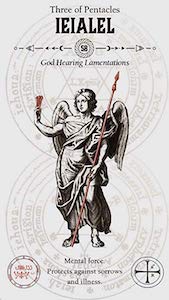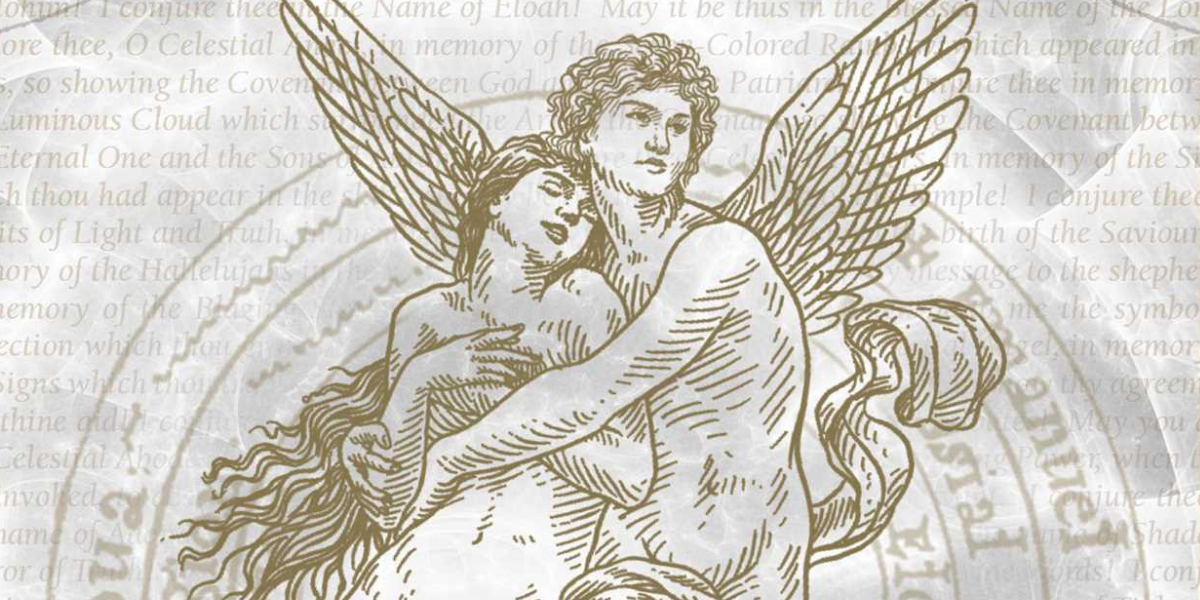
Angel Tarot, by Travis McHenry
Rockpool Publishing, 1925924206, 72 cards, 122 pages, April 2020
Many angel oracle or tarot decks feature sweeping images of light, splendor, and magnificence, along with a comforting affirmation of the angels’ eternal love and devotion. While Angel Tarot by Travis McHenry does facilitate this sacred connection to the power of the angels, the deck is unique because it also offers sigils, seals, and ancient grimoire knowledge to invite the angels into your life. Working with the Angel Tarot allows you to do more than just your standard tarot reading; the energy of the angels is yours to evoke, meditate with, and conjure for magical purposes.
Travis McHenry is a seasoned occultist that has had a varied career. He has an academic background in anthropology and has studied a variety of religions; he was even ordained as a deacon in the Baptist church at one time. McHenry also served in the United States Navy as an intelligence specialist. Afterwards he became a recruiter for the largest telephone psychic company in the world.1 Previously to publishing this deck, McHenry created The Occult Tarot, which is a 78-card deck featuring daemons of the 17th century with guidance on demon conjuration according to Solomonic principles.
It is McHenry’s incorporation of high magic that makes Angel Tarot very different from the usual New Age angel oracle cards or tarot decks. Every card features the tarot correspondence, the angel’s divine name, angelic number, few word description of the meaning of the name, astrological meaning of the card and angel, the angel’s abilities, summoning sigil, and magical seal. I realize this may not make sense to someone who doesn’t have much experience with high magic, but McHenry offers enough guidance that even a novice would be able to effectively use the cards to summon angels.
The guidebook introduction describes Cornelia Agrippa’s doctrine about every human being born with three guardian angels. McHerny describes the difference between each guardian angel, but leaves it up to the deck user to figure out which angels are their guardians. Then there is a brief overview of the hierarchy of angels. I have written a series about the different angels, so if you’re interested you can read a general overview here.

From here, McHenry provides succinct and straightforward directions to conjure angelic spirits. He even includes an image of the Grand Pentacle of Solomon to keep practitioners safe while using the deck. For those who wish to evoke an angel using one of the cards, there is a script for before and after the evocation. McHenry’s directions make it very easy to choose an angel from the deck to petition, connect with the angel, state your request, and then formally end the ritual. I absolutely love the ability to use the cards as a focal point while summoning angels. Angel magic has been what I plan on devoting my studies to this year, and the Angel Tarot is the perfect accompaniment for this undertaking in a safe, contained manner.
Other ways to use the cards suggested by McHenry are meditation and divination. Meditation can attune someone to the angel of your choice’s energy if they do not feel up for doing the full evocation ritual, and is what I would recommend from someone just getting used to the system of this method of working with angels. Then for those doing divination, McHenry writes, “When reading with this deck your answers may come from the tarot connection, the angel’s astrological connection or the angel’s ability.”2 This gives a lot of versatility with this deck, along with plenty of room to explore the different angel correspondences for study and oracular purposes. So far I’ve enjoyed working with the cards more for meditation than divination.
The rest guidebook is the description of meaning for each card. Fair warning, it is not in the style of a usual guidebook that will explicitly state what the card means. Each description has a biblical verse, photograph of the card, and information about when the angel is the soul, mortal, or physical guardian (excluding the six archangels, which have almost the exact same description on their card). This information is how one can find out who their three guardian angels are if they are interested in fostering a relationship with them in particular. The guidebook also shares the intonation for each angel’s name, which is important for ritual evocation, and rank in the angel hierarchy. I learned my moral and soul guardian are the same angel!

There are no specifics given about how the cards relate to the tarot other than this card is this tarot correspondence and guidance on how to do some common tarot spreads. Therefore you should already be familiar with the energy of tarot, otherwise you will not be able to make the associations as easily. Even without knowing the tarot correspondence though, there’s still value in this deck as a method to work with angels. I say this to ensure that someone who sees the title Angel Tarot knows that the main focus is on the 78 angels.
The cards in the deck are gorgeous. They are all coated in gold trim and have The Grand Pentacle of Solomon on the back and in the background of the front of the cards as all. The color scheme of gold, grey, and white hues give the deck a sleek, classical feeling. The images on the front of the cards look like Renaissance sketches. There’s a complexity to the simplicity to the cards, for they all look clean-cut but are filled with sigils, seals, imagery, and words that all seem to attract the eye at once. Red and black emphasize the imagery on some cards, making them more pronounced and striking as one looks through the deck.
I highly recommend Angel Tarot to anyone looking to establish a practice of summoning angels, enhancing their high magic practice, or learn more about the kabbalah hierarchy of angels. While it seems more suited for an experienced occultist, this deck is absolutely user-friendly for people to work with at a beginner level. As I delve into my year of dedicated study of the angels, I am very grateful to have this deck as an enhancement to work I plan on doing. McHenry has done a wonderful job of synthesizing arcane grimoires, occult knowledge, and magical practice to create an outstanding deck.
Alanna Kali is an astrologer, numerologist, and pioneer spirit that loves to explore life through the lens of depth psychology. She has a passion for studying the humanities and social trends. Her academic work is centered upon reuniting body, mind, and spirit through eco-psychology. She loves reading, spending time in nature, and travel.

[…] life to arcane occult knowledge, and for this I immensely appreciate his work. His previous decks Angel Tarot, Vlad Dracula Tarot, and Occult Tarot have a palpable energy to them, and this deck is no […]